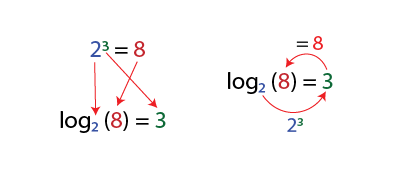What are cents in music?
José Rodríguez Alvira
Cents, powers and logarithms
Cents are based on the mathematical concept of logarithms. Logarithms were introduced by the Scottish mathematician John Napier (1550/4-1617). The name comes from logos (ratio) and arithmós (number). Logarithms are related to powers.
Two to the third power or \( 2^3 \) equals 1 x 2 x 2 x 2:
\( 2^3 = 1 * 2 * 2 * 2 = 8 \)
Two to the fourth power:
\( 2^4 = 1 * 2 * 2 * 2 * 2 = 16 \)
This is a tricky example that shows why we should start with 1:
\( 2^0 = 1 \) (1 multiplied by no 2)
The following figure illustrates the relationship between powers and logarithms:

Two, raised to the third power equals 8 ( \( 2 ^ 3 = 8 \) ). The logarithm indicates the power to which we must raise 2 to obtain 8. The second line reads: base 2 logarithm of 8 = 3. In other words, what power do we have to raise 2 (base 2) to get 8? The answer is 3.
In music we use base 2 logarithms because octaves inherently use this base. To find the frequency of a note an octave away, we need to multiply the frequency of the first note by two. Let us take C2 at 60 Hz. This gives us the frequency of C3:
\[ C3 = 60 * 2 = 120 \]
To get to C4, we multiply by 2, twice:
\[ C4 = 60 * 2 * 2 = 240 \]
Or we can use powers:
\[ C4 = 60 * 2^2 = 60 * 4 = 240 \]
The exponent used is related to the number of octaves:
| Note | Octaves | Power | Frequency |
| \[ C2 \] | 0 | 0\[ 2^0 = 1 \] | 60 Hz. \[ 60 * 2^0 = 60 * 1 = 60 \] |
| \[ C3 \] | +1 | 1\[ 2^1 = 2 \] | 120 Hz.\[ C3 = C2 * 2^1 = 60 * 2 = 120 \] |
| \[ C4 \] | +2 | 2\[ 2^2 = 4 \] | 240 Hz.\[ C4 = C2 * 2^2 = 60 * 4 = 240 \] |
| \[ C5 \] | +3 | 3\[ 2^3 = 8 \] | 480 Hz.\[ C5 = C2 * 2^3 = 60 * 8 = 480 \] |
Now let's use logarithms:
- Let's use the frequencies of C5 (480 Hz.) and C3 (120 Hz.). The notes are at two-octave distance.
- We divide the frequencies and the result is 4:
\( 480 / 120 = 4 \)
- What is the logarithm base 2 of 4, or what power must we raise 2 to get 4? The answer is 2, just as the number of octaves.
\( log_2(4) = 2 \)
- If we multiply C2's frequency \(2^2 \) we get C4's frequency:
\( 120 * 2^2 = 480 \)
We get the same result by subtracting the powers. The power needed to reach C5 from C2 is 3 (see the table above), that of C3 is 1. If we subtract 3 - 1, we get 2, the same result we obtained with \( log_2 (4) = 2 \).
Inadvertently, we are almost at Ellis' formula for calculating cents:
We divide the note frequencies and find the base 2 logarithms of the result.
There is only one small detail missing. We will see this in the next section.
It can all be confusing. It is like a labyrinth of mirrors in which it is easy to get lost. You have to go through it many times, with a lot of patience, and little by little you will find your way...
Let's summarize the mathematical concepts learned:
| Powers: | \( \color{red}2 \color{blue}^3 \color{black}= 1 * 2 * 2 * 2 = \color{green}8 \) | Multiply 1 by 2 three times | Logarithms: | \( log\color{red}_2 \color{black} ( \color{green}8 \color{black} ) = \color{blue}3 \) | At what power should we raise 2 to get 8? |
|---|
If you can go from powers to logarithms and vice versa, you can consider the concept understood!

This work is licensed under a Creative Commons Attribution-NonCommercial-NoDerivatives 4.0 International License.
Published by teoria.com.